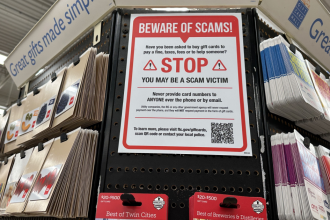Credit Sesame helps you safeguard your finances by explaining how to avoid credit card skimming scams.
Credit card skimming remains a significant threat in 2025, with fraudsters continually evolving their tactics to steal financial information. If a scammer gains access to your credit card details and racks up unauthorized charges, it could impact your credit utilization and potentially harm your credit score. Understanding what affects your credit score and how skimming works so you can adopt preventive measures can significantly reduce your risk of falling victim to these scams.
What is credit card skimming?
Credit card skimming involves unauthorized devices attached to legitimate card readers, such as those at ATMs, gas pumps, or point-of-sale terminals. These devices capture data from your card’s magnetic stripe, enabling criminals to create counterfeit cards or conduct fraudulent transactions. Skimming can also occur through Radio Frequency Identification (RFID) skimming, exploiting wireless technology to access card information without physical contact.
In recent years, skimming technology has become more advanced, with thieves using sophisticated methods such as overlay skimmers, deep-insert skimmers, and Bluetooth-enabled devices that transmit stolen data in real-time. Because of these developments, consumers must be extra vigilant when using their cards.
Recent trends in skimming attacks
Despite advancements in payment security, skimming incidents continue to rise. In the first half of 2023, the number of U.S. debit cards involved in skimming increased by 77%, from approximately 70,000 to nearly 120,000. Moreover, sophisticated fraud rings have been identified installing skimming devices at various retail locations, including major supermarket chains.
One growing concern is the emergence of “shimming,” a skimming variation targeting chip-enabled cards. Unlike traditional skimmers, which steal data from magnetic stripes, shimmers intercept the data during a chip transaction, making them harder to detect.
Another alarming trend is the use of hidden cameras alongside skimmers. These cameras record PIN entries, allowing fraudsters to access accounts and withdraw funds without a physical card. This tactic has been observed at ATMs and self-checkout stations in grocery stores.
How to spot a skimming device
Being vigilant can help you identify potential skimming devices before you use your card. Here are some key signs to watch for:
- Inspect the card reader. Before inserting your card, examine the card reader for unusual features such as misaligned parts, bulky attachments, or mismatched colors. Be cautious if the reader looks different from others at the same location.
- Check for loose or wobbly components. Legitimate card readers are securely attached. If the card slot or keypad feels loose or moves, it could indicate tampering.
- Compare with other machines. If possible, compare the machine you’re using with others nearby. Differences in appearance or functionality may signal a compromised device.
- Look for hidden cameras. Thieves sometimes install tiny cameras above keypads to capture PIN entries. If you notice any unusual holes or small attachments near the machine, it may contain a hidden camera.
- Use NFC and tap-to-pay options. Tap-to-pay methods like Apple Pay and Google Pay are generally safer than inserting a physical card. Skimming devices cannot intercept NFC transactions.
Preventive measures to protect your card information
To minimize the risk of skimming, consider the following strategies:
- Use contactless payment methods. Opt for tap-to-pay options or mobile wallets instead of swiping or inserting your card. These methods offer enhanced security.
- Cover the keypad. When entering your PIN, shield the keypad with your hand to prevent hidden cameras from capturing your input.
- Monitor your accounts regularly. Frequently review your bank and credit card statements for unauthorized transactions. Early detection can help mitigate potential losses.
- Set up account alerts. Enable notifications for transactions on your accounts. Immediate alerts can inform you of suspicious activity promptly.
- Use RFID-blocking wallets. To protect against RFID skimming, consider using wallets or sleeves that block unauthorized scans of your card’s information.
- Avoid card readers in high-risk locations. Skimmers are more commonly found at outdoor ATMs, gas stations, and self-service kiosks. Use ATMs inside bank branches or retail stores with surveillance cameras when possible.
What to do if you suspect skimming
If you suspect your card information has been compromised, take immediate action:
- Contact your card issuer immediately. Report the unauthorized activity to your bank or credit card company. They can freeze your account and issue a new card.
- Monitor your statements. Keep a close eye on your financial statements for any further unauthorized transactions.
- Report to authorities. File a report with local law enforcement and inform the Federal Trade Commission (FTC) about the fraud. Additionally, notify the business where you suspect the skimming took place.
- Change your PIN. If your debit card was involved, change your PIN to prevent further unauthorized access.
- Consider fraud alerts or a credit freeze. If your personal information has been stolen, placing a fraud alert on your credit report or freezing your credit can help prevent identity theft.
How banks and retailers are fighting skimming fraud
Financial institutions and businesses have implemented stronger security measures to combat skimming fraud. Many banks now use advanced fraud detection systems that flag suspicious transactions in real-time. Additionally, new anti-skimming technologies, such as jitter technology (which disrupts data collection on chip readers) and tamper-resistant ATMs, are being deployed to make skimming more difficult.
Retailers also help prevent skimming at checkout counters by adopting end-to-end encryption for card transactions. This ensures that sensitive card information is protected from interception by fraudsters.
Despite these efforts, consumers must remain proactive in protecting their financial information. By staying informed and cautious, you can reduce your risk of falling victim to credit card skimming scams.
Staying vigilant against skimming threats
Protecting yourself from skimming is just one part of maintaining strong financial security. Regularly checking your credit report and monitoring your credit activity can help detect fraud early. Free credit monitoring can alert you to any unusual activity on your accounts, helping you stay one step ahead of potential threats.
As skimming techniques become more sophisticated, it’s crucial to remain vigilant and proactive in protecting your financial information. By adopting secure payment methods, regularly monitoring your accounts, and staying informed about the latest fraud trends, you can significantly reduce the risk of falling victim to credit card skimming scams.
If you enjoyed How to protect yourself from credit card skimming scams you may like,
Disclaimer: The article and information provided here are for informational purposes only and are not intended as a substitute for professional advice.
Read the full article here














